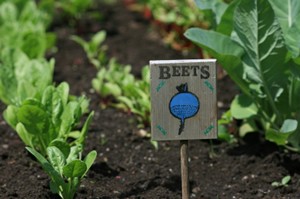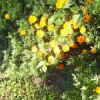Some people have labeled them victory gardens. Others call them recession gardens, crisis gardens--even survival gardens. No matter what you call them, industry surveys are showing a double digit increase in the number of folks starting vegetable gardens this year. If you want to jump into the wonderful world of gardening, it's not too late. There is no better way to increase your health while stretching your food budget dollars! Here are a few important first steps to getting started.
Most vegetables need a minimum of 6-8 continuous hours of sun per day. The site should be somewhat protected from wind, and offer good drainage. You'll want to plant taller crops on the north and west sides of your site to avoid shading your shorter crops. Sketching your plans on graph paper may be helpful at this stage in your planning.
Good luck!
This page contains the following solutions.
Take time to plan your garden, on paper, to make the most of what space you have available. Keep track of the brands and varieties you use, that you might like to plant again, next year.
Here are the questions asked by community members. Read on to see the answers provided by the ThriftyFun community.
I am starting a vegetable garden and am looking for tips and what vegetables give you the best results. I only have a small space to grow them in.
Hardiness Zone: 7a
It more or less depends on what you like. Some things like radishes, can be replanted several times. The main things that I planted when I was young and had a garden was green beans, tomatoes and cucumbers. I then canned a lot of stuff, tomatoes, pickles, etc. For corn to be real productive, other than for daily use while it is season, you have to plant a lot. We did plant one row of corn every year, and that wasn't enough for canning or anything. The same with potatoes it takes a lot of plants to reap enough to save for the winter.
The best thing I can tell you is that no matter what you grow, you have to pay attention to the soil, the sun, the water, nutrients in the soil, and temperature.
Soil is really important because that's where the roots that feed the plants spend all of their time, and like us, they like certain things better than others. Do you know about soil types? Digging up soil? Adding amendments/fertilizers? Is your land on a slope, is your land deep down, prone to flooding? All these things factor in, and at first it can sound overwhelming, but many people do it. If you can, check out books at a local library to help you get started, that's what I did. Learn all about your soil, and the type of soil you have. Did you know that plant roots need oxygen that they get from under the soil? The soil can't be so compacted hard or clay/watery that the roots drown, since they don't have any gills for oxygen. A couple of years ago, we had a torrential downpour, over 11 inches of rain in a couple of days from a storm off the west coast, and I'm by the great lakes! It was raining so hard that my sunflowers were drooping, and I instinctively knew they would drown. I took a garden hoe out, and made several small trenches in the soil, even taking some soil out, but not exposing the sunflowers roots, and the sunflowers made it because I geared up and dug them trenches to take the water away.
Vegetable gardens needs hours and hours of sunshine depending on what you want to grow. The best vegetable gardens have full sunshine, about 12 to 15 hours of sunlight a day. No shade from trees or big shrubs, but most vegetables can be grown from less sunshine.
Vegetable gardens require lots and lots of water. It's not like watering indoor houseplants. At first, when you put in seeds, or have small plants, they don't need a lot of water, because they are so small, but as the temperatures warm up, and the season goes on, the veggies keep growing so quickly, they need lots of water. I like to water deep about once a week, because it's said the roots grow deeper and better that way, but that can't always be followed. It depends on the weather.
If you want a good garden, you must be mindful of the weather, everyday. If your garden is starting to wilt, and a big rain is coming, water a little to stop the wilting leaves, but leave the rest of the watering for the big rain. And if you just got a big rain, be happy, and don't water. If you have a really big rain coming up, just lightly water, if your garden needs water, or it will be over watering, and you can't take back mother nature rains. If the top inch or so of soil is dry, water.
Look at your plants everyday. You will soon learn what leaf wilting means. If you have a plant whose leaves are erect in the morning, and you haven't checked the soil, and you see the leaves drooping way down, it's time to water--even if the weather said it would rain, and the radar doesn't show any rain at all.
If you get up every morning, and check your plants throughout the day, just like children, you'll come to know what they need.
I use commercial fertilizer, but I don't use any commercial pesticides/fungicides, etc. When it's time for me to plant, I add composted cow manure, top soil, peat moss and the fertilizer to the top of the soil so I can see it, then I turn it under a few times by tiller, or shovel. Then I level everything off, but I step in as few places as I can. Then I plant the seed or seedlings, again, stepping in as few places as possible, because the roots like aerated, fluffy soil--that way they get oxygen even though they are under the soil.
Okay, now you know you are in zone 7a, so you need to find out what type soil you have, if it needs amended to make it better, how much sun will your area get everyday during growing season, keep an eye on the weather for rain/no rain, where you have to water,or not water, and what kinds of fertilizers will you use before planting, and possibly after planting, depending on your garden.
I started out in what I considered a small space, and wound up giving veggies away. The neighbors didn't care for their garden--they just left it to the elements, and were lucky if they had three tomatoes at the end of the season.
You don't have to spend all day long, every day on a garden, be watchful of the sun, water, soil, temperature, soil conditions, leaf wilt, and you will have a wonderful garden. It is hard at first, but after the first season, if you're like me, you will want to do it over and over and over again, and you will become a pro at it!
My first year, with my mom and her girlfriends help, with the library books, I grew tomatoes, green beans, cucumbers, muskmelons, small watermelons, and that peppery stuff some people put in salads, and I went on to grow so many other things, zucchini, spinach, curled head lettuce, mustard, peas, if you can, try peas, swiss chard, pumpkins, and I grew annual flowers, too.
I have a special tip for you. The first year I was learning to grow all of this, we had the remnants of a hurricane headed our way, in zone 5a, and they said to tie things down, well, I had beautiful marigolds on the north and west side of the garden, and I was scared to lose them, so I put twine all in and around them, and those horrible hurricane winds took a lot of things, but my mixed marigolds all twined up, made it through that nasty hurricane wind.
Best to you on your small space, and know, small is relative, it's better to say size like 5 by 10, etc. I really hope this helps.
We are getting ready to plan our garden for next year. This is our second year. Last year, we had a great success with broccoli, but we noticed that it was done producing by early to mid summer. What can we plant in it's place? Other items we are planning on growing so far are zucchini, green peppers, jalapenos, and tomatoes. Thanks.
Hardiness Zone: 5a
By Jen Hummell from Shellsburg, IA

You have the right idea. You can also plant any kind of peas,beans & other veggies,call your county extension office they will send you all the info you need on gardening. You can grow food all the time, greens, onions & etc in winter time & the above in summer time, good luck.
Above writer has great ideas. You can also read the tag on your brocolli starts/seeds and if it's not a hybrid let one or two plants go to seed, and then use the dry seed to start more brocolli in about September for a fall crop.
How far apart do I plant cucumbers in a 65' by 65' garden? Also, how far apart to plant tomatoes and peppers in a 65' by 65' space?
By Amy D.
Well, the hubster and I just bought a new (to us) house. It has a good size yard and I would like to plant a garden next spring, but I haven't grown anything in probably 20 years.
I already have a spot on the west side of the house picked out and want to make some plans of what to plant. What types of vegetables would be good (and easy) ones to start out with the first season?
I don't want to sprout seeds from scratch, as I don't have grow lights. I also want to grow my vegetables organically. I tried going to the public library for books on the subject, but they were either too general or about organic flower gardening. Any advice is appreciated.
Hardiness Zone: 6a
By Barbara Pope from Pittsburg, KS
I've found this site to have very good advice for the beginner (as I am) www.thegardenhelper.com/
Also check your local county extension office, you'll find they have a great master gardeners program and you can get some great local help from people who've been trained, that can begin to connect you with local gardeners. Computers are great but there's nothing like getting to know gardeners so you can trade and barter while learning new things.
O and you might also check to find a local seed company. I have found one, here in Oregon, which also grows what they sell so I know I, at least, stand a chance of getting similar results, because the plants grow here, and yes I buy many live plants from here too. Best of luck and have a great time in the garden, planning and all.
Many vegetables such as tomatoes, squash, and peppers grow well in the desert heat. You will be able to grow more types of veggies by planting earlier in the year to avoid the summer heat. Choose a good location, water appropriately, and mulch as needed. This is a page about planting a desert vegetable garden.
Canning your own fruits and vegetables is be rewarding and frugal. Plus, jars of summer produce make a wonderful present. This is a page about planning a canning and preserve garden.
ThriftyFun is one of the longest running frugal living communities on the Internet. These are archives of older discussions.
I am new at this gardening thingy. My daughter and I have planted watermelon, pumpkin, corn, green beans and sunflowers.